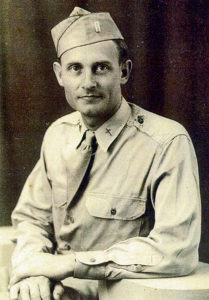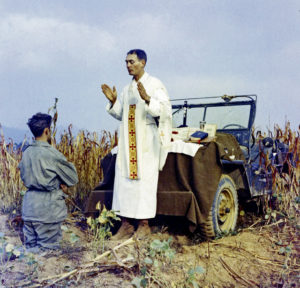
The Defense POW/MIA Accounting Agency announced today that Army Chaplain (Capt.) Emil J. Kapaun, of Pilsen, Kansas, who died as a prisoner of war during the Korean War, was accounted for March 2.
After serving in World War II, Kapaun returned to active duty in the U.S. Army and served in the Korean War with the 8th Cavalry Regiment, 1st Cavalry Division. On November 2, 1950, his unit was near Unsan when they came under heavy fire from Chinese forces and received orders to withdraw.
Approximately a quarter of the unit’s soldiers made their way back to friendly lines. The others, including many wounded soldiers, became trapped. Kapaun volunteered to stay with the wounded, and was soon captured and taken to a Chinese-run prison camp on the Yalu River’s south bank known as Camp 5.
Even after he became gravely ill, Kapaun continued to serve as a spiritual leader for his fellow prisoners, encouraging them to faithfully await their release and regularly defying his captors to bolster the collective morale of the POWs. Due to prolonged malnutrition, he died on May 23, 1951, after which the other POWs buried him in one of the camp’s cemeteries.
As part of the 1953 Korean Armistice Agreement, Kapaun’s remains were among the 1,868 who were returned to U.S. custody, but they were not able to be identified. At a White House ceremony on April 11, 2013, President Barack Obama posthumously awarded Kapaun the Medal of Honor for extraordinary heroism and selflessness.

Kapaun’s remains had rested among the 867 remains buried as “Unknowns” at the National Memorial Cemetery of the Pacific in Hawaii. His remains were disinterred and identified as part of DPAA’s Korean War Disinterment Project, a seven-phase plan begun in 2018, to disinter all remaining Korean War Unknowns from the NMCP.
In 1993, Pope John Paul II declared Kapaun a Servant of God, the first stage toward possible canonization, which is the culmination of the Roman Catholic Church’s recognition of a deceased person as a saint.
For additional information on the Defense Department’s mission to account for Americans who went missing while serving our country, visit the DPAA website at www.dpaa.mil, or find us on social media at www.facebook.com/dodpaa or https://www.linkedin.com/company/defense-pow-mia-accounting-agency.
Kapaun’s personnel profile can be viewed at https://dpaa-mil.sites.crmforce.mil/dpaaProfile?id=a0Jt00000004mBjEAI.


